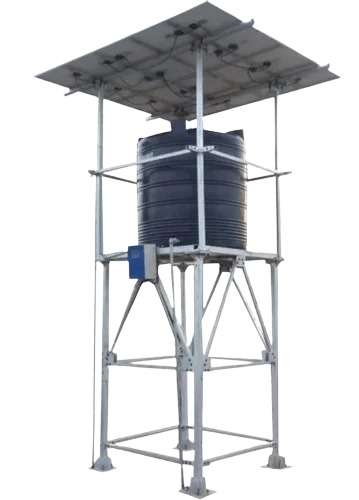
In various residential, commercial, industrial, and agricultural applications, water storage is a critical need. Among the many types of water tanks available, metal-structured water tanks have earned a reputation for their strength, durability, and long-term reliability. These tanks are specifically designed with a robust metal framework that ensures structural integrity even under heavy loads and challenging environmental conditions.
Whether it's for drinking water, irrigation, fire protection, or industrial use, a metal structure water tank offers a secure and efficient way to store large volumes of water.
A water tank with a metal structure refers to a water storage tank that is supported or fully constructed from metal materials—typically galvanized steel, stainless steel, mild steel, or aluminum. The metal serves as the primary structural component, providing the framework, walls, and support for the tank’s capacity.
Depending on the use case, metal tanks can be installed above ground, underground, or elevated on platforms or towers. The tanks can be cylindrical, rectangular, or custom-shaped, and may be lined internally with protective coatings or liners to prevent corrosion and contamination.

Tank Shell (Wall Panels)
Made of heavy-duty metal sheets, these panels form the vertical body of the tank. They are usually corrugated or ribbed to provide additional strength.
Roof Structure (Optional)
For covered tanks, metal roofing protects the stored water from external contamination, UV exposure, and debris.
Bottom/Base Plate
The floor of the tank is constructed using metal plates or a reinforced concrete base, depending on tank design.
Support Framework
In elevated or tower-mounted tanks, steel columns, trusses, or bracings are used to hold the tank securely at height.
Access Ladders and Platforms
Metal ladders, safety rails, and platforms are included for maintenance and inspection access.
Protective Coating or Liners
Internal surfaces are often coated with epoxy, polyurethane, or food-grade liners to prevent corrosion and maintain water purity.
Metal tanks are ideal for large-scale water storage due to their ability to withstand high pressure and weight. This makes them suitable for industrial and municipal applications.
When properly maintained, metal tanks can last 20 to 50 years or more. Galvanized or stainless steel resists rust, corrosion, and UV damage.
Many metal tanks are available in modular panel designs, which are easy to transport and assemble on-site. This flexibility is especially useful in remote or rural locations.
Unlike plastic tanks, metal structures can endure high temperatures without deforming, making them ideal for areas with intense sun or variable climates.
Steel is non-combustible, offering added protection in fire-prone environments or for fire water reserve tanks.
Metal tanks can be customized from a few thousand liters to several million liters, meeting the needs of homes, factories, farms, or city water systems.
Drinking Water Storage: For municipalities, housing societies, and rural areas
Irrigation: Large-capacity tanks for farms and plantations
Fire Protection: Reserve water supply for firefighting systems
Rainwater Harvesting: Storage of harvested rainwater in urban or rural setups
Industrial Use: Process water storage, cooling systems, and chemical mixing
Construction Sites: Temporary water supply and site management
Bolted Steel Tanks
Made of pre-fabricated panels bolted together on-site. Easy to ship and install, and available with internal liners.
Welded Steel Tanks
Constructed by welding steel plates on-site. Offers high strength and is ideal for very large capacities.
Stainless Steel Tanks
Used where hygiene and corrosion resistance are critical—such as in food, pharmaceutical, or drinking water storage.
Galvanized Steel Tanks
Coated with a layer of zinc to resist corrosion. Cost-effective and durable for general-purpose water storage.
Regular Cleaning: Drain and clean tanks annually to prevent sediment build-up.
Inspect for Corrosion: Look for rust or surface wear, especially at joints and seams.
Recoat When Needed: Apply protective coatings as required to extend tank life.
Check for Leaks: Monitor fittings, valves, and base structure for water seepage.
Maintain Ladders and Platforms: Ensure all access points are safe and rust-free.
A metal structure water tank is a reliable and powerful solution for storing large volumes of water across diverse applications. With their robust design, long service life, and flexible configurations, these tanks are a preferred choice for both urban infrastructure and remote projects. Whether you're a homeowner looking for a long-term solution or an industry professional seeking high-capacity storage, metal tanks provide efficiency, safety, and strength—making them a smart investment for the future.























